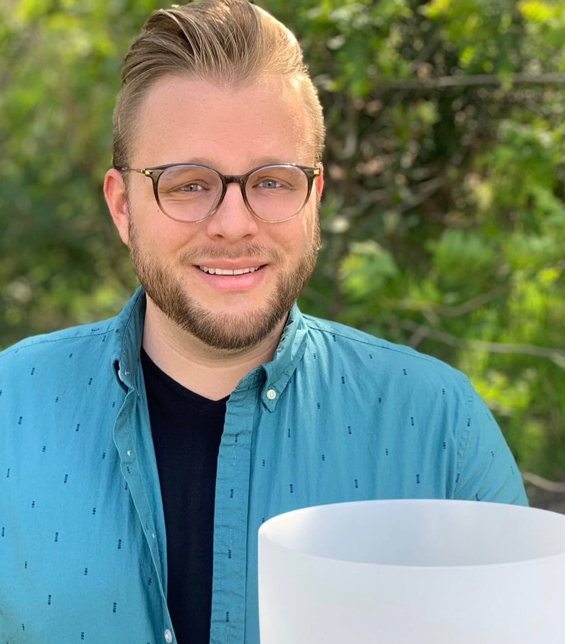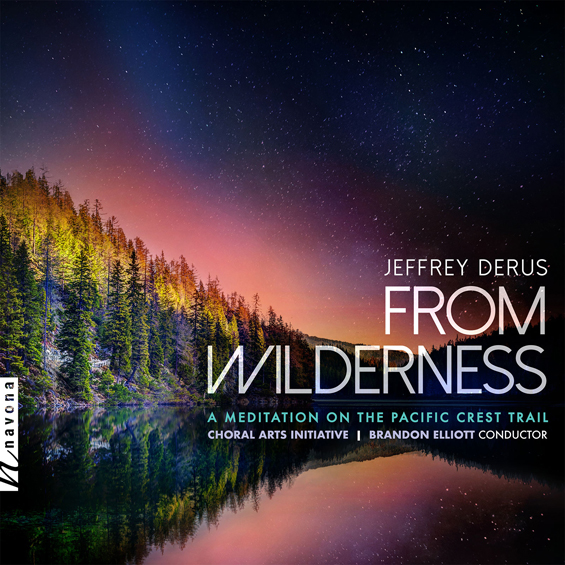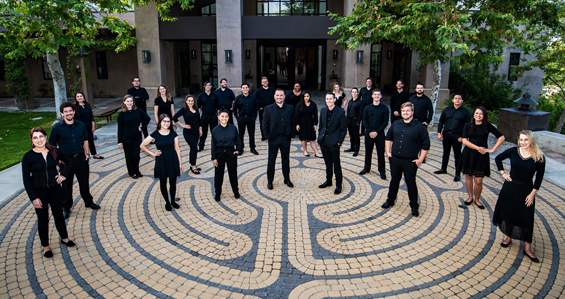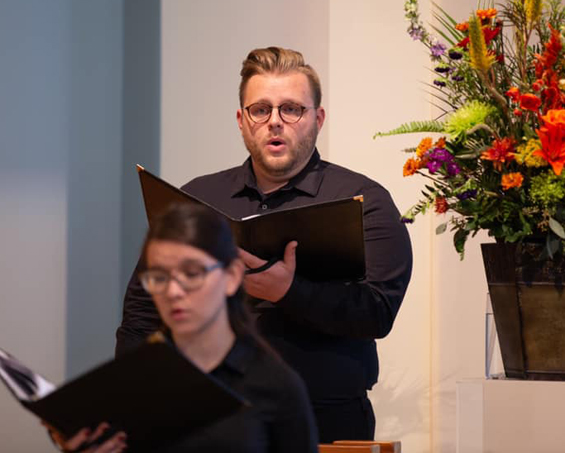

photo: Choral Arts Initiative
FIVE QUESTIONS WITH JEFFREY DERUS
The recent Navona Records release, From Wilderness: A Meditation on the Pacific Crest Trail, is significant for being the first concert-length recording from the Southern California-based Choral Arts Initiative ensemble; it's even more noteworthy, however, for having been composed by one of the company's tenors and founding board members, Jeffrey Derus. The work is a remarkable creation that showcases his impressive gifts as a composer as well as the artistry of the vocal ensemble and conductor Brandon Elliott, cellist Kevin Mills, and eight crystal bowl players (see the textura review here). A graduate of California State University of Fullerton and Brandman University, Derus has drawn upon personal memories of exploring sites along the Pacific Crest Trail during family summer vacations to compose a profound celebration of the natural wilderness and the potentially transformative impact it can have on us. textura had a chance to speak with Derus recently about this singular work and how it came into being.
1. From where did the idea for your premiere concert work From Wilderness: A Meditation on the Pacific Crest Trail originate? Did it come from your own transformative experience traveling the route?
From Wilderness was created in collaboration with Brandon Elliott, Choral Arts Initiative, and the Pacific Crest Trail Association. With this being my first concert-length work, I wanted it to be my original thoughts and concepts but open to collaboration with everyone involved. When Brandon asked me to write Choral Arts Initiative's first concert-length work, I immediately said yes. Given the remarkable work his ensemble delivers every performance, I knew this was going to be one of the most incredible projects I will ever be a part of.
The idea of using the Pacific Crest Trail (PCT) as the anchor of the work came from my own experience in nature. Although I have not completed a “thru-hike” of the PCT, I have been to many locations and stretches of the trail. Growing up in California, my parents took my sisters and me to many of the major stops on the trial for summer vacations. From Palm Springs to Mammoth, Yosemite to Lake Tahoe and through the wildernesses of Oregon and Washington, the trail weaves in and out of stunning locations along the West Coast. Being immersed in nature and having such wonderful memories there, I knew I wanted to write about the power nature has on mind, body, and spirit.

2. What made you decide to structure the work as you did, specifically in its coupling of chakras and vocal sections?
The PCT was the literal map for creating the structure of From Wilderness. I wanted to overlay a form of sound therapy that echoed the healing power of nature, thus infusing the crystal singing bowls into the work. The major sections of the work are the five major sections of the trail. Beginning with Southern California, you move through the Sierras, Northern California, Oregon, and lastly Washington. The smaller movements within the major sections are the stops along the trail. The idea is that if someone is hiking the PCT they could play a small movement from the work that relates to either the beauty of that exact location or the feeling one has at that part of the trail.
The crystal singing bowl movements introduce a new section of the trail, allowing for a moment of self-reflection and self-healing. The audience is experiencing a sound bath, a form of sound healing. Every time a crystal bowl movement occurs the audience is given a moment to centre and reset a particular chakra, thus bringing realignment of their overall well-being.
3. Could you talk a bit about the texts you chose for the different sections and how you determined the pairings of poets and sections? Were there things in the trail's geographical locales that suggested specific texts and authors?
After reading many journals and accounts of hikers that have completed the PCT, I built an emotional map that emulated what the hikers might be feeling at each part of the trail. The trail takes a person on many different journeys, from physically to emotionally to spiritually. Each hiker went through a multi-dimensional healing process. So, the through-line of text selection was important. I chose texts from authors and poets that are grounded in nature. A major inspiration for text selections was John Muir who understood nature in a way that felt divine and sacred.

photo: Choral Arts Initiative
4. As much as the work focuses on five sections of the trail, it's as much about inner journeying, isn't it? What do you hope listeners will derive from the experience of absorbing the work?
The outer journey is only half of the transformation one has along the trail. The inner journey is one that many people do not acknowledge until they're in the thick of it, about a third of the way through the trail. I want the listener to meditate on the text, the sounds, the beauty of nature, the beauty of who we are as humans, and how they all relate. The work offers many mantras, but one that gave this work its name is by my husband, Matthew Derus, “From wilderness I was made.”
We are all on different journeys in our lives and all have many journeys within our lives. But one thing is that we are created in the wildernesses of the world and our minds. We have all that we need within us to overcome anything, and when we find ourselves lost, we must look inward for strength. John Muir once said, “For going out, was really going in.”
5. It's interesting that AllMusic described your music as “akin to that of Holy Minimalism” when From Wilderness suggests some measure of affinity to the compositional style of John Tavener, his Mary of Egypt, for example. From Wilderness isn't an explicitly religious work in the way his are, but there are nonetheless deeply spiritual and meditative dimensions to it. Further to that, there's a ritual-like aspect to the piece in the way its parts alternate between those featuring crystal singing bowls and those with the singers and cellist Kevin Mills. Did From Wilderness develop free of such influences or did they factor into its creation?
From Wilderness is naturally a work that shines light on the holiness of nature and the power we can find in those earthly places. Regarding the compositional style, there are moments that feel sacred and meditative. The work is intended to be healing and transformative, thus giving nods to other works that offer those same qualities.

photo: Choral Arts Initiative
BONUS QUESTION: From Wilderness is a work that originally was set to premiere in March of 2020, but due to the nationwide shutdown was instead recorded in the studio in July 2021. Given that the sessions occurred after the singers spent sixteen months apart, what was the experience like of everyone reuniting for the recording? The work was also presented in concert for its world premiere on April 24th in Newport. What was it like seeing it presented for the first time live?
The postponement of the premiere was at first devastating but later became a blessing. From the recording to the premiere, everyone involved went through a life-changing journey during the pandemic. Not that the pandemic was a blessing in anyway, but the time spent apart made everyone turn inward for healing. So when we reunited to record the album and later for the premiere, we all understood the impact this piece had and will have when we can emote and perform the music more authentically.
At the concert premiere, the audience was silent for some time, as they were in a place of stillness and serenity, but roaring applause erupted thereafter. The success of the work was amplified by the extended time we all had, and I would not change that journey for anything.website: JEFFREY DERUS
June 2022![]()